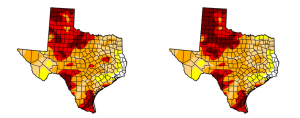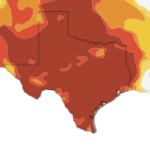This Week in Drought: The Biggest Losers
While the overall percentage of the state suffering from drought did not increase from last week, six percent of Texas, mostly in the Panhandle, sunk deeper into it.

U.S. Drought Monitor Archives
The dark red represents the most severe level of drought. It spread to cover more than six percent of the state in the past week, most notably in the panhandle.
The U.S. Drought Monitor maps show exceptional drought spreading in North and West Texas in the past week, with less severe drought levels decreasing in other parts of the state.
The National Weather Service Climate Prediction Center forecasts the drought will continue for the western half of the state, including the Panhandle.
State climatologist Dr. John Nielsen-Gammon says that much of the state already suffering from drought will likely experience a hotter-than-normal and drier-than-normal summer.
“Even if we just get normal rainfall it would be great,” Gammon tells StateImpact Texas. “But the trouble is any gaps in rain will cause things to dry out again. It’s more a matter of getting repeated regular rain than any single amount.”
Neilsen-Gammon says areas in West and North Texas have received occasional rain, but that much of it evaporated before it was able to sink into the ground. Hot weather would cause additional stress on crops and lead to faster evaporation.
This echoes much of what to National Weather Service Southern Region climate program manager Victor Murphy recently told StateImpact Texas. Murphy said the “losers” in drought are the Panhandle area, parts of South Texas, and Northwest Texas, around Wichita Falls.
“The two worst areas are the Rio Grande area into Deep South Texas and the Texas High Plains and Panhandle from the Lubbock area, or the Big Spring area northward,” Murphy said.
Forecasters predict some of these areas might see some severe weather, including rainfall, by the end of the month. Nielsen-Gammon says the rain will help, but not as much as it could.
“Back in September parts of West Texas got up to 10 inches of rain, which was great for reservoirs around San Angelo” Nielsen-Gammon says. “The rain in one burst didn’t help nearly as much as if it had spread out for many events.”
Murphy and Nielsen-Gammon expect tighter water restrictions on farmers and potentially on residents of drought-afflicted regions if the hot, dry weather expected this summer occurs.

